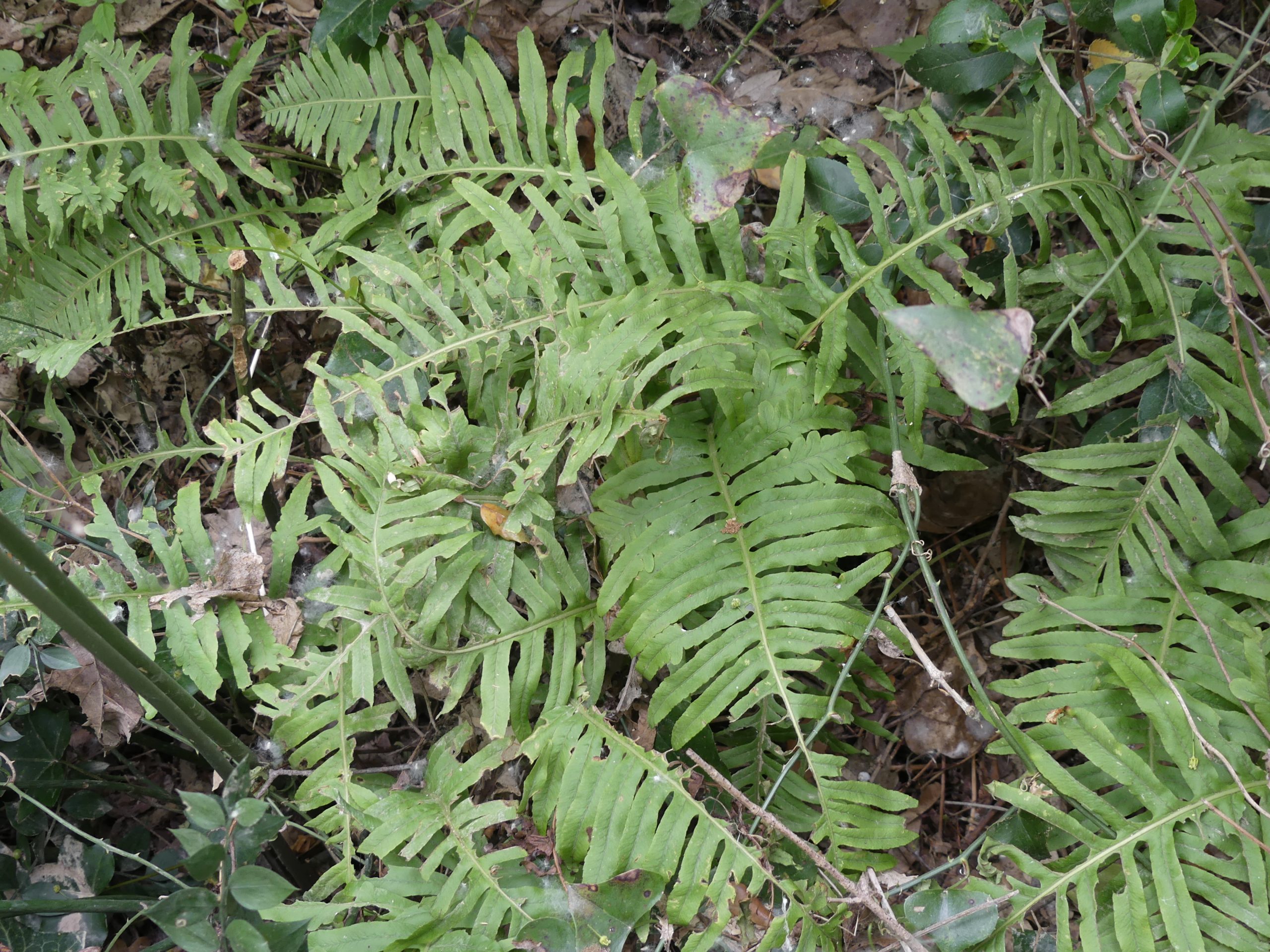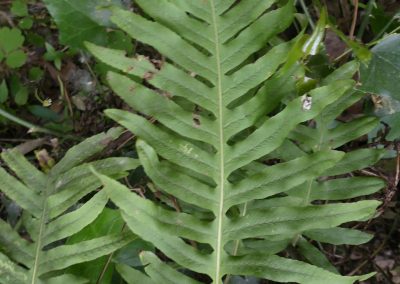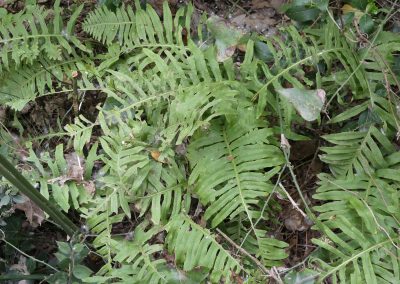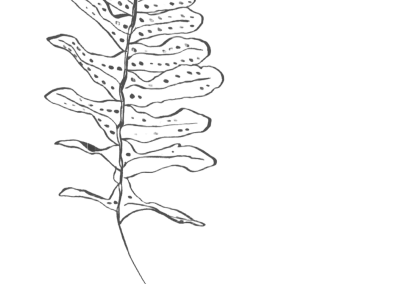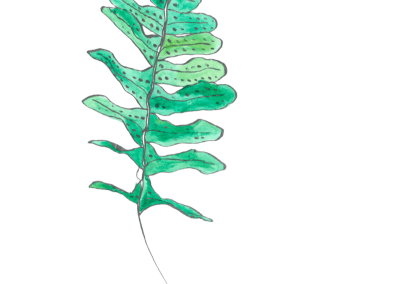Polypodium cambrium
Scientific description
Taxon: Polypodium cambricum
Class: Polypodiopsida
Subclass: Polypodiidae
Order: Polypodiales
Family: Polypodiaceae
Common name: Southern polypody, common polypody
Origin:
Europe (southwest, Corsica, Pyrenees), Mediterranean regions.
Description:
Perennial rhizomatous fern forming compact tufts. Fronds persistent, leathery, bipinnate to pinnate, 20–40 cm, dark green and glossy. Sori in rows on underside of pinnules, protected by thin circular indusium. Prefers shaded, humid environments: rocky cliffs, shaded walls, cool woods. Frost resistant, adapts to calcareous or siliceous soils.
Propagation:
By spores dispersed by wind; vegetative by rhizome division.
Ecology:
Plant of shaded, humid habitats, often in mountainous and Mediterranean zones. Contributes to vegetative cover on rocks, limiting erosion.
Uses:
Mainly ornamental in shade gardens and rockeries. Former medicinal use as expectorant.
Threats:
Not threatened. Common in natural habitat but sensitive to destruction of rocky environments.
Taxon: Polypodium cambricum
Classe: Polypodiopsida
Sous-classe: Polypodiidae
Ordre: Polypodiales
Famille: Polypodiacées
Nom commun: Polypode de Corse, Polypode commun
Origine:
Europe (sud-ouest, Corse, Pyrénées), régions méditerranéennes.
Description:
Fougère vivace rhizomateuse formant des touffes compactes. Frondes persistantes, coriaces, bipennées à pennées, 20–40 cm, limbe vert foncé et brillant. Sores alignés sur le revers des pinnules, protégés par indusie circulaire fine. Préfère milieux ombragés et humides: falaises, murs ombragés, bois frais. Résistante au froid, s’adapte aux sols calcaires ou siliceux.
Multiplication:
Par spores dispersées par le vent; multiplication végétative par division du rhizome.
Écologie:
Plante des milieux ombragés et humides, souvent en zones montagneuses et méditerranéennes. Participe à la couverture des rochers, limitant l’érosion.
Utilisation:
Principalement ornementale dans jardins d’ombre et rocailles. Usage médicinal ancien expectorant.
Menace:
Non menacée. Plante courante, sensible à la destruction des milieux rocheux.
Taxon: Polypodium cambricum
Clasă: Polypodiopsida
Subclasă: Polypodiidae
Ordin: Polypodiales
Familie: Polypodiaceae
Nume comun: Polipodul din Corsica, polipod comun
Origine:
Europa (sud-vest, Corsica, Pirinei), regiuni mediteraneene.
Descriere:
Ferigă perenă, rizomatoasă, formează tufe compacte. Frunze persistente, cărnoase, bipenate sau penate, 20–40 cm, verde închis și lucioase. Sori în rânduri pe partea inferioară a pinnulelor, protejați de indusiu subțire și circular. Preferă medii umbrite și umede: stâncării, ziduri umbrite, păduri răcoroase. Rezistentă la frig, adaptabilă solurilor calcaroase sau silicioase.
Propagare:
Prin spori dispersați de vânt; vegetativ prin divizarea rizomului.
Ecologie:
Plantă a habitatelor umbrite și umede, frecventă în zone montane și mediteraneene. Contribuie la acoperirea vegetativă a stâncilor, limitând eroziunea.
Utilizare:
Mai ales ornamentală în grădini umbrite și rocații. Folosire medicinală veche ca expectorant.
Amenințări:
Nu este amenințată. Plantă comună, dar sensibilă la distrugerea mediilor stâncoase.
Ταξινόμηση: Polypodium cambricum
Κλάση: Polypodiopsida
Υποκλάση: Polypodiidae
Τάξη: Polypodiales
Οικογένεια: Polypodiaceae
Κοινή ονομασία: Πολυπόδιο της Κορσικής, κοινό πολυπόδιο
Προέλευση:
Ευρώπη (νοτιοδυτικά, Κορσική, Πυρηναία), Μεσογειακές περιοχές.
Περιγραφή:
Πολυετής ριζωματώδης φτέρη που σχηματίζει συμπαγείς συστάδες. Φύλλα επίμονα, δερματώδη, διπλο-φτερωτά έως φτερωτά, 20–40 εκ., σκούρο πράσινο και γυαλιστερό. Σπόριες σε σειρές στην κάτω όψη των φυλλαρίων, προστατευόμενες από λεπτό κυκλικό ινδύσιο. Προτιμά σκιερά, υγρά περιβάλλοντα: βραχώδεις πλαγιές, σκιεροί τοίχοι, δροσερά δάση. Ανθεκτικό στο κρύο, προσαρμόζεται σε ασβεστολιθικά ή πυριτικά εδάφη.
Διάδοση:
Με σπόρια από τον άνεμο; ασεξουαλική αναπαραγωγή με διαίρεση του ριζώματος.
Οικολογία:
Φυτό σκιερών και υγρών οικοτόπων, συχνά ορεινά και μεσογειακά. Συμβάλλει στην κάλυψη βράχων, περιορίζοντας διάβρωση.
Χρήσεις:
Καλλωπιστικό σε σκιασμένους κήπους και βραχόκηπους. Παλαιότερη φαρμακευτική χρήση ως αποχρεμπτικό.
Απειλές:
Δεν απειλείται. Κοινό φυτό, ευαίσθητο στην καταστροφή βραχωδών περιοχών.
Creative writing inspired by Polypodium cambrium
Polypod and Jasmine
Once upon a time, a beautiful young girl wandered around a castle picking polypodium to save her mother's life, since this plant was known to help with liver disorders.
Suddenly, armed with her magic wand, a wicked old witch cast a spell on the beautiful young girl, transforming her into an ugly goblin. The witch took her to a cage in the basement of the castle, and said: “I'll leave you here for the rest of your life so you won't pick my polypodium again.”
She went back up to the castle's great hall and found her son Polypod sitting on a large sofa, asking her who she had just captured. She told him it was a young polypodium thief. “Why does she steal polypodium?” he asked. The mother said he didn't want to know why she was stealing polypodium. Intrigued, Polypod went to the basement to see the imprisoned girl. Polypod didn't see a girl, but an ugly little elf. He asked where the girl was, and the goblin told him that she really was, confiding that it was the witch who had transformed her.
Polypod didn't think his mother was capable of casting a spell on a young girl without knowing why. The elf told him she wanted to pick polypodium because her mother was very ill. Polypod asked if she needed help. The surprised elf said “yes” but remained wary. Polypod asked the elf to stay in the basement and went to get the keys to free her.
Polypod went back up to the living room, found his mother asleep, stole the keys, and returned to the basement. They returned to the living room to retrieve the magic wand. Polypod took it and removed the curse.
Once done, Polypod marveled at the girl's beauty and asked her name. She said her name was Jasmine. They went to the castle courtyard to pick polypodium to save the sick mother. They crossed the dark forest, reached Jasmine's house, and found her weak mother lying on the sofa. Polypod rushed into the kitchen to concoct the magic potion with polypodium as the ingredient. He gave her the potion. The mother woke up cured and thanked Polypod.
Jasmine explained everything that had happened. Then they returned to the castle to apologize for stealing the polypodium. Polypod's mother forgave her and apologized for imprisoning her without reason. Polypod found Jasmine beautiful and courageous and asked for her hand. They lived happily ever after.


